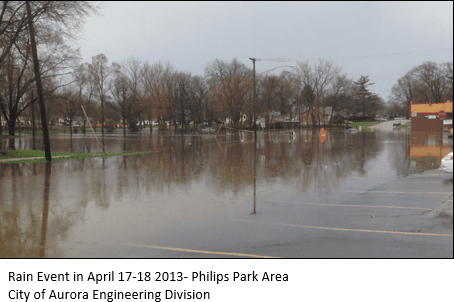Flood Plain Information
The City Public Work/Engineering Division is a repository for the Flood Insurance Rate Maps (FIRM), and floodplain studies produced by Federal Emergency Management Agency (FEMA). As such the general public is invited to view any of these maps and studies during normal business hours. Please note that this information is also available on FEMA website. Some floodplain studies are also available from IDNR OWR office.
City staffs play a critical role in making the City a safer and more resistant communities to natural disaster. The City identify flood hazards and then act to reduce those risks along with managing these risks to a higher standard to make the City a stronger more resilient community. To determine if your property is located within the floodplain, please use the following links to search.
Floodplain Mapping and Insurance
Floods are unpredictable and flood risk is always changing. The City uses tools to understand risk and take actions to protect families, homes, and businesses located within the floodplain. Below are links to various website for more information on floodplain
Federal Emergency Management Agency (FEMA)
Quick Property Search. Is my property in the floodplain? Use the links below to search your property.
Request for floodplain information by the City of Aurora. Please complete the form below and email this to the City's Engineering Division.
What if you are in the floodplain and want to change your flood zone designation?
Engineers and surveyors play an important role in updating flood hazard maps and providing data. This section helps you understand the Letter of Map Change (LOMC) process and FEMA requirements. Letter of Map Change (LOMC) is a general term used to refer to the several types of revisions and amendments to FEMA maps that can be accomplished by letter. They include Letter of Map Amendment (LOMA), Letter of Map Revision (LOMR), and Letter of Map Revision based on Fill (LOMR-F). Below are links to LOMC process and information.
Local Floodplain Management
FEMA Technical Manuals/Technical Bulletins
The National Flood Insurance Program (NFIP) Technical Bulletins provide guidance for complying with the NFIP’s building performance requirements. Useful resources for homeowners, insurance agents, building professionals, and designers. These technical bulletins can be found on this link.
Example of Technical Bulletins are:
-
Technical Bulletin 1, Openings in Foundation Walls and Walls of Enclosures (2020)
-
Technical Bulletin 3, Non-Residential Floodproofing Requirements and Certifications
-
Technical Bulletin 6, Below-Grade Parking Requirements
-
Technical Bulletin 10, Ensuring That Structures Built on Fill in or Near Special Flood Hazard Areas Are Reasonably Safe from Flooding
Community Rating System
The Community Rating System (CRS) is a voluntary incentive program that recognizes and encourages community floodplain management practices that exceed the minimum requirements of the National Flood Insurance Program (NFIP). Over 1,500 communities participate nationwide, which includes the City of Aurora. In CRS communities, flood insurance premium rates are discounted to reflect the reduced flood risk resulting from the community’s efforts that address the three goals of the program.
-
Reduce and avoid flood damage to insurable property.
-
Strengthen and support the insurance aspects of the National Flood Insurance Program.
-
Foster comprehensive floodplain management.
By conducting mitigation and outreach activities that increase safety and resilience, including CRS credits for regulating to higher standards, the City can earn credits and discounts on flood insurance premiums for property owners within the City limits. More information about the CRS program can be found on the FEMA website: Community Rating System | FEMA.gov.
The City of Aurora is Class 7 community

The City of Aurora Adopts the Kane County Natural Hazards Mitigation Plan
Kane County Illinois is subject to natural hazards that threaten life and health and have caused extensive property damage. To better understand these hazards and their impacts on people and property, and to identify ways to reduce those impacts, the County’s Department of Environmental Management and Office of Emergency Management jointly undertook this Natural Hazards Mitigation Plan.
This Plan was prepared by the Natural Hazards Mitigation Planning Committee (NHMPC), created by a resolution of the Kane County Board. The Committee’s members include representatives of County offices, interested municipalities, and public and private stakeholder organizations. The City is an active member of the NHMC. The Plan identifies activities that can be undertaken by both the public and the private sectors to reduce safety hazards, health hazards, and property damage caused by natural hazards. It focuses on the five major natural hazards facing Kane County: floods, tornadoes, earthquakes, thunderstorms and winter/ice storms. The City formally adopted the Natural Hazard Mitigation Plan in 2010.


Floodsmart
This is an official site of the National Flood Insurance Program. The NFIP offers flood insurance to help you protect the life you’ve built and recover more quickly after a flood.
Floodplain Warning & River Stage & Stream Gages
The NWS provides weather, water, and climate data, forecasts, warnings, and impact-based decision support services for the protection of life and property and enhancement of the national economy. Weather forecast and flooding risk are provided on the NWS website.
The United States Geological Survey (USGS) provides useful tools and data, including stream gages on the current streamflow condition and gage/river height. Stream gages are used nationwide to predict and address flood conditions.